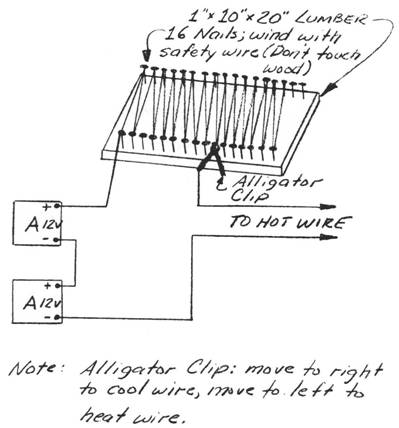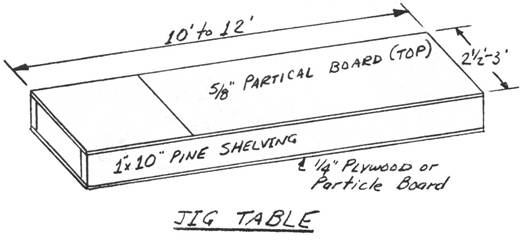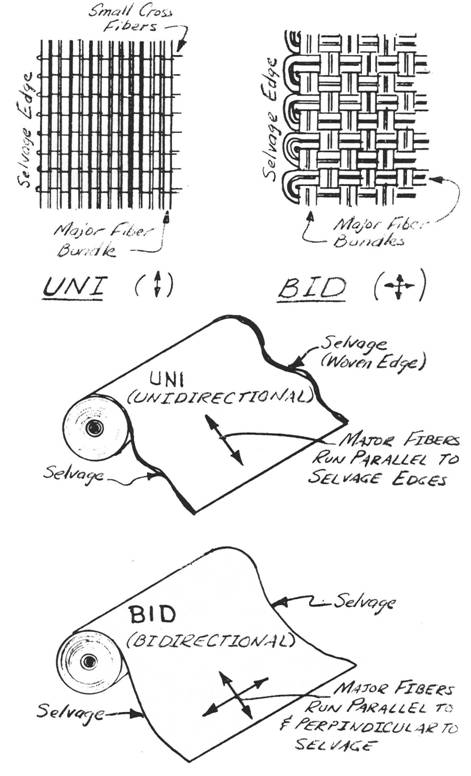Q2 Plans Chapter 3 Page 3-2
- Details
- Category: Q-2/Q-200 Plans
- Published: Sunday, 28 May 2006 03:05
- Written by Quickie Aircraft Corporation
- Hits: 6823
..... The variable voltage control can be obtained from Aircraft Spruce and Specialty or Wicks Aircraft Supply, or you can substitute any controllable power supply to include the 14 to 20 volt range with at least 4 amp capability. An alternative is to borrow two 12-V battery chargers or auto batteries and lash up the following device. The "A" blocks represent either a battery or a 12-V dc battery charger with a 4 amp capability.  ..... The cutter should only be used on the blue-white or orange styrofoam. A hazardous gas is emitted if you try to cut urethane. .....You can substitute .025 nichrome wire which can be run at a lower current (about 2 amp) but nichrome wire is difficult to find. Adjust the current to obtain a wire temperature which will allow the wire to cut the foam at a rate of one inch every four to six seconds when pulled with a light load (less than ! pound). This can be checked with a small scrap of foam. If temperature is correct, the foam will have smooth hairy surface. A cratered surface means too much heat. If the wire is too cold, the cutter will have to be forced hard, causing the wire to lag. Lag should not exceed 1 inch over the top and bottom of the wing and not over 1/8 inch around the leading edge. If the wire is too hot, it will burn away too much foam, making the part too small and will result in ruts in the foam if the wire is inadvertently stopped during cutting. The wire should be tightened until the wire starts to yield. Check this by tightening the wire while plunking it, listening to the sound. The pitch will increase until the wire yields. Jig Table ..... You will need a table to jig and build the wings and canard. It should be at least 2 ft by 10 ft. Any larger than 4 ft. by 12 ft. will just get in the way. Use a little care in making a flat, untwisted surface. The following is a sketch of the one we made and it works fine. The box design makes it stiff in torsion. Set it up with the top 35 to 39 inches above the floor. Don't get carried away with surface finish, since you are going to be gluing blocks to it with Bondo and chiseling them off several times. .....When building the wing and canard, which are nearly 17 ft long, one can extend the jig table with lumber (2x4's) and Bondo (see section on Bondo) to provide a platform for the top jigging templates.  MATERIALS
Fiberglass Cloth ..... The most basic structural material in your Q2 is glass cloth. Glass cloth is available commercially in hundreds of different weights, weaves, strengths, and working properties. The use of glass in aircraft structures, particularly structural sandwich composites, is a recent development. Very few of the commercially available glass cloth types are compatible with aircraft requirements for high strength and light weight. Even fewer are suitable for the handlayup techniques used in the Q2. The glass cloth used in the Q2 has been specifically selected for the optimum combination of workability, strength, and weight. .....The glass cloth in your Q2 carries primary loads, and its correct application is of vital importance. Even though doing your glass work correctly is important, this doesn't mean that it is difficult. .....Two types of glass cloth are used, a bi-directional cloth (5277BID), and a unidirectional cloth (5177UND). (Use the full part number for ordering your cloth, but for simplicity the plans will use only BID or UNI designations). BID cloth has half of the fibers woven parallel to the selvage edge of the cloth and the other half at right angles to the selvage, giving the cloth the same strength in both directions. The selvage is the woven edge of a bolt of fabric as shown in the accompanying sketch.  | ||||
CONTINUED ON NEXT PAGE | ||||
PAGE 3-2 | ||||



